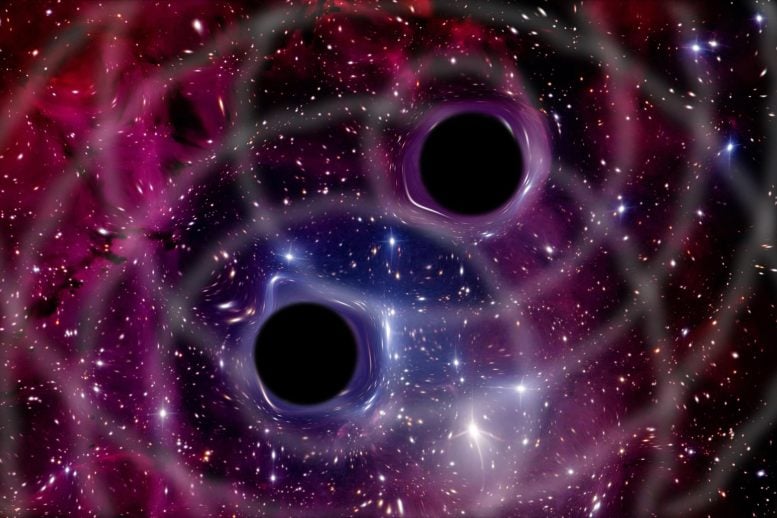
A record-breaking black hole collision has stunned scientists with its sheer scale and speed.
Detected by the LIGO-Virgo-KAGRA observatories, the event merged two enormous black holes—each over 100 times the mass of the Sun—into a single, spinning cosmic titan. The final result? A black hole more than 225 times the Sun’s mass, spinning near the limits allowed by physics. The discovery not only breaks previous size records, but also shakes up what we thought we knew about how black holes form.
Massive Black Hole Merger Stuns Scientists
The LIGO-Virgo-KAGRA (LVK) Collaboration has made a groundbreaking discovery, detecting the most massive black hole merger ever recorded using gravitational waves. This detection was made possible by the LIGO observatories in Hanford and Livingston, which are supported by the US National Science Foundation (NSF). The resulting black hole, formed from the merger, weighs over 225 times more than our Sun. The signal, labeled GW231123, was captured during the LVK network’s fourth observing campaign (O4) on November 23, 2023.
The two black holes involved in the merger had estimated masses of about 100 and 140 times that of the Sun. Along with their extraordinary size, they were spinning at extreme speeds. This combination made the signal particularly difficult to analyze and suggests that these black holes may have an unusually complex origin story.
Gravitational waves are tiny ripples in spacetime created by extremely energetic cosmic events, such as the collision of massive objects like black holes or neutron stars. These waves travel outward from their source at the speed of light, stretching and squeezing space as they go. Although incredibly faint by the time they reach Earth, gravitational waves carry valuable information about the nature, motion, and structure of the objects that produced them, offering a unique way to observe the universe beyond what light alone can reveal.
A Formation Mystery Beyond Standard Models
“This is the most massive black hole binary we’ve observed through gravitational waves, and it presents a real challenge to our understanding of black hole formation,” says Professor Mark Hannam, from Cardiff University and a member of the LIGO Scientific Collaboration. “Black holes this massive are forbidden through standard stellar evolution models. One possibility is that the two black holes in this binary formed through earlier mergers of smaller black holes.”
Scientists have now observed around 300 black hole mergers via gravitational waves, including new candidates from the current O4 run. Before GW231123, the largest confirmed black hole binary was linked to the event GW190521, which had a significantly lower total mass of “only” 140 times the mass of the Sun.
Pushing the Boundaries of Detection
The high mass and extremely rapid spinning of the black holes in GW231123 pushes the limits of both gravitational-wave detection technology and current theoretical models. Extracting accurate information from the signal required the use of theoretical models that account for the complex dynamics of highly spinning black holes.
“The black holes appear to be spinning very rapidly—near the limit allowed by Einstein’s theory of general relativity,” explains Dr. Charlie Hoy at the University of Portsmouth. “That makes the signal difficult to model and interpret. It’s an excellent case study for pushing forward the development of our theoretical tools.”
Researchers are continuing to refine their analysis and improve the models used to interpret such extreme events. “It will take years for the community to fully unravel this intricate signal pattern and all its implications,” states Dr. Gregorio Carullo, Assistant Professor at the University of Birmingham. “Despite the most likely explanation remaining a black hole merger, more complex scenarios could be the key to deciphering its unexpected features. Exciting times ahead!”
Gravitational-Wave Astronomy Enters a New Era
Gravitational-wave detectors such as LIGO in the United States, Virgo in Italy, and KAGRA in Japan are designed to measure minute distortions in spacetime caused by violent cosmic events like black hole mergers. The fourth observing run began in May 2023, and observations from the first part of the run (up to January 2024) will be published later in the summer.
“This event pushes our instrumentation and data-analysis capabilities to the edge of what’s currently possible,” says Dr. Sophie Bini, a postdoctoral researcher at Caltech. “It’s a powerful example of how much we can learn from gravitational-wave astronomy—and how much more there is to uncover.”
Explore Further: Cosmic Heavyweights Collide – LIGO Detects Largest, Fastest-Spinning Black Holes Yet
GW231123 was presented at the 24th International Conference on General Relativity and Gravitation (GR24) and the 16th Edoardo Amaldi Conference on Gravitational Waves, held jointly as the GR-Amaldi meeting in Glasgow, UK. The calibrated data used to detect and study GW231123 will be made available for other researchers to analyse through the Gravitational Wave Open Science Center (GWOSC).
Never miss a breakthrough: Join the SciTechDaily newsletter.
6 Comments
There is no spacetime – other than figuratively. There is no place where there is empty space and ‘space’ is an animal brain construct but not exist; and time is another. Remember we invented clocks. Tick-tock, lunch-breaks? Brains create concepts like memory – but the Universe doesn’t.
We invented clocks to measure time… as long as you’re digesting something, or you’re seeing something move, time exists.
‘Black holes this massive are forbidden through standard stellar evolution models’. This is untrue and the problem with Scitechdaily,com using AI to write their articles.
That’s a quote from the researcher lol. Why would that be AI generated
Read the “mass gaps” section of the Wikipedia article on stellar black holes.
TON 618, one of a handful of extremely distant and massive black holes for which astronomers have direct measurements. This behemoth contains more than 60 billion solar masses, and it boasts a shadow so large that a beam of light would take weeks to traverse it.
By Francis Reddy
NASA’s Goddard Space Flight Center, Greenbelt, Md.